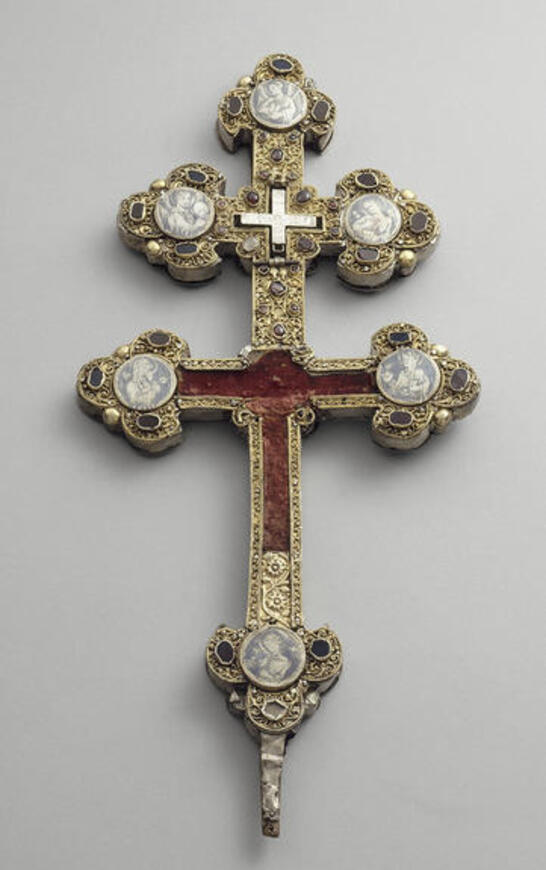The main face housed the relic, in the small cross-shaped cavity on the first crosspiece. Now lost, it has been replaced with an engraved silver plate representing the Crucifixion. On either side, medallions show the Virgin and the apostle Saint John, both witnesses of Christ's death. On the lower crosspiece, we find the Church and the Synagogue, symbols of the Old and New Testament. Two angels can be seen on the upper and lower medallions.
On the reverse, Christ appears sat on a throne, framed by two images of angels. Below, a lamb symbolises Christ's sacrifice. Four other winged figures appear. They make up the Tetramorph and symbolise the four evangelists: John, Luke, Mark and Matthew.
Various objects of this nature were created in the north of France and the Meuse region in the 13th century. The production of so-called staurotheke crosses (from the Greek "staurós", cross, and théke, "container") began after the fourth crusade. In 1202, Christians sought to reconquer the Holy Land. But, lacking silver, they turned towards Constantinople, which they pillaged in 1204. The treasures brought back by these Crusaders included relics of the True Cross, presented in these reliquaries. These were all distinguished by abundant decoration, and the Lille specimen was no exception.
Detail 1:
The decoration of the main face features filigree (small metal wires, twisted or decorated with pearls), enhanced with cabochons (polished stones) set into the decoration, as well as silver medallions.
Detail 2:
The silver plates decorated with niello (a black alloy) are of exceptional quality. These are reminiscent of the style of the 1200s, marked by the influence of ancient forms. The fluid treatment of the draping and naturalist appearance of the animals and acanthus leaves bear witness to this.

The main face housed the relic, in the small cross-shaped cavity on the first crosspiece. Now lost, it has been replaced with an engraved silver plate representing the Crucifixion. On either side, medallions show the Virgin and the apostle Saint John, both witnesses of Christ's death. On the lower crosspiece, we find the Church and the Synagogue, symbols of the Old and New Testament. Two angels can be seen on the upper and lower medallions.
On the reverse, Christ appears sat on a throne, framed by two images of angels. Below, a lamb symbolises Christ's sacrifice. Four other winged figures appear. They make up the Tetramorph and symbolise the four evangelists: John, Luke, Mark and Matthew.
Various objects of this nature were created in the north of France and the Meuse region in the 13th century. The production of so-called staurotheke crosses (from the Greek "staurós", cross, and théke, "container") began after the fourth crusade. In 1202, Christians sought to reconquer the Holy Land. But, lacking silver, they turned towards Constantinople, which they pillaged in 1204. The treasures brought back by these Crusaders included relics of the True Cross, presented in these reliquaries. These were all distinguished by abundant decoration, and the Lille specimen was no exception.
Detail 1:
The decoration of the main face features filigree (small metal wires, twisted or decorated with pearls), enhanced with cabochons (polished stones) set into the decoration, as well as silver medallions.
Detail 2:
The silver plates decorated with niello (a black alloy) are of exceptional quality. These are reminiscent of the style of the 1200s, marked by the influence of ancient forms. The fluid treatment of the draping and naturalist appearance of the animals and acanthus leaves bear witness to this.